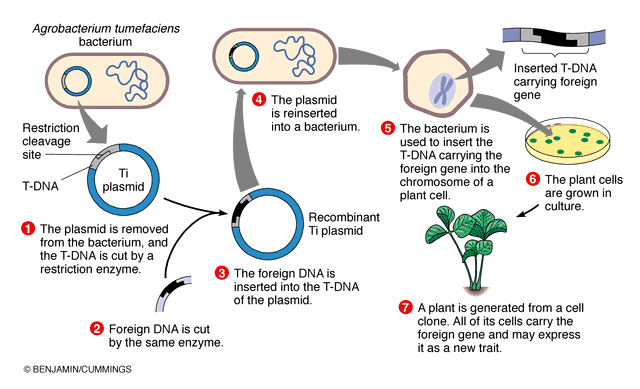How are organisms genetically modified?
Genetic engineering is the modification of an organism's phenotype by manipulating its genetic material. Some genetic engineering uses the principle of recombination.
Recombination is the process through which a new gene is inserted into a bacterial DNA "The plasmid". The DNA needs to be cut with an enzyme called a restriction enzyme. The restriction enzyme used must have a specific shape that allows it to move along the DNA that is to be cut. The restriction enzyme looks for a specific point in the DNA sequence at which to cut the DNA. When the restriction enzyme cuts, it leaves a "Sticky end" which helps a new gene to attach at that point. Another enzyme is used to attach the new DNA segment; this is called "DNA ligase". Genetically engineered bacterium is cultured and many new copies of the bacteria with the new gene are grown. Genetic modifications can be made to both plants and animals.
The video below illustrates the mechanism of recombination.
Agrobacterium is bacteria that uses a Horizontal gene transfer (HGT). HGT is the transfer of DNA between different genomes [Pop up: A genome is the complete set of genetic material present in an organism]. HGT can occur in bacteria through transformation, conjugation and Transduction. However, it is also possible for HGT to occur between eukaryotes and bacteria though the mechanism for this transfer is not well understood.
Bacteria have three ways of transferring bacteria between cells:
- Transformation: The uptake and incorporation of external DNA into the cell thereby resulting in the alteration of the genome
- Conjugation: The exchange of genetic material through cell-to-cell contact of two bacterial cells. A strand of plasmid DNA is transferred to the recipient cell and the donor cell then synthesis DNA to replace the strand that was transferred to the recipient cell.
- Transduction: A segment of bacterial DNA is carried from one bacterial cell to another by a bacteriophage. The bacteriophage infects a bacterial cell and takes up bacterial DNA. When this phage infects another cell, it transfers the bacterial DNA to the new cell. The bacteria can then become a part of the new host cell.
Agrobacterium also has the ability to transfer DNA between itself and plants and is therefore commonly used in genetic engineering. The process of using Agrobacterium for genetic engineering is illustrated in the diagram below.

Summary of process illustrated in the diagram (above):
- The agrobacterium cell contains a bacterial chromosome and a Tumor inducing plasmid- "Ti Plasmid".
- The Ti plasmid is removed from the agrobacterium cell and a restriction enzyme cleaves the T-DNA restriction site.
- Next foreign DNA, which is also cleaved by the same enzyme, is inserted into the T DNA at the site that was cleavage site.
- The modified plasmid is then reinserted in the agrobacterium and the bacterium inserts the TDNA, which now carries a foreign gene into the plant cell.
- The plant cell is then cultured and results in a new plant that has the foreign DNA trait.
The following video illustrates the process of using Agrobacterium for genetic engineering.
Activity not available on mobile devices (description)